A Ycf2-FtsHi Heteromeric AAA-ATPase Complex Is Required for Chloroplast Protein Import
- PMID: 30309901
- PMCID: PMC6305978
- DOI: 10.1105/tpc.18.00357
A Ycf2-FtsHi Heteromeric AAA-ATPase Complex Is Required for Chloroplast Protein Import
Abstract
Chloroplasts import thousands of nucleus-encoded preproteins synthesized in the cytosol through the TOC and TIC translocons on the outer and inner envelope membranes, respectively. Preprotein translocation across the inner membrane requires ATP; however, the import motor has remained unclear. Here, we report that a 2-MD heteromeric AAA-ATPase complex associates with the TIC complex and functions as the import motor, directly interacting with various translocating preproteins. This 2-MD complex consists of a protein encoded by the previously enigmatic chloroplast gene ycf2 and five related nuclear-encoded FtsH-like proteins, namely, FtsHi1, FtsHi2, FtsHi4, FtsHi5, and FtsH12. These components are each essential for plant viability and retain the AAA-type ATPase domain, but only FtsH12 contains the zinc binding active site generally conserved among FtsH-type metalloproteases. Furthermore, even the FtsH12 zinc binding site is dispensable for its essential function. Phylogenetic analyses suggest that all AAA-type members of the Ycf2/FtsHi complex including Ycf2 evolved from the chloroplast-encoded membrane-bound AAA-protease FtsH of the ancestral endosymbiont. The Ycf2/FtsHi complex also contains an NAD-malate dehydrogenase, a proposed key enzyme for ATP production in chloroplasts in darkness or in nonphotosynthetic plastids. These findings advance our understanding of this ATP-driven protein translocation system that is unique to the green lineage of photosynthetic eukaryotes.
© 2018 American Society of Plant Biologists. All rights reserved.
Figures
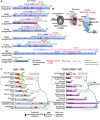
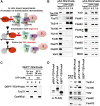
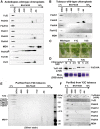
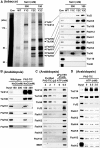

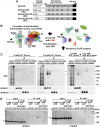

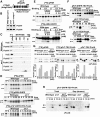
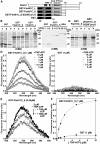
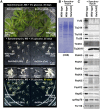
Comment in
-
A Force-Generating Machine in the Plant's Powerhouse: A Pulling AAA-ATPase Motor Drives Protein Translocation into Chloroplasts.Plant Cell. 2018 Nov;30(11):2646-2647. doi: 10.1105/tpc.18.00751. Epub 2018 Oct 11. Plant Cell. 2018. PMID: 30309903 Free PMC article. No abstract available.
-
Protein Import Motors in Chloroplasts: On the Role of Chaperones.Plant Cell. 2020 Mar;32(3):536-542. doi: 10.1105/tpc.19.00300. Epub 2020 Jan 13. Plant Cell. 2020. PMID: 31932485 Free PMC article. No abstract available.
-
Reply: The Revised Model for Chloroplast Protein Import.Plant Cell. 2020 Mar;32(3):543-546. doi: 10.1105/tpc.19.00821. Epub 2020 Jan 14. Plant Cell. 2020. PMID: 31937598 Free PMC article. No abstract available.
Similar articles
-
Conservation and specialization of the Ycf2-FtsHi chloroplast protein import motor in green algae.Cell. 2024 Oct 3;187(20):5638-5650.e18. doi: 10.1016/j.cell.2024.08.002. Epub 2024 Aug 27. Cell. 2024. PMID: 39197449
-
Structural insights into the chloroplast protein import in land plants.Cell. 2024 Oct 3;187(20):5651-5664.e18. doi: 10.1016/j.cell.2024.08.003. Epub 2024 Aug 27. Cell. 2024. PMID: 39197452
-
Chloroplast import motor subunits FtsHi1 and FtsHi2 are located on opposite sides of the inner envelope membrane.Proc Natl Acad Sci U S A. 2023 Sep 12;120(37):e2307747120. doi: 10.1073/pnas.2307747120. Epub 2023 Sep 5. Proc Natl Acad Sci U S A. 2023. PMID: 37669373 Free PMC article.
-
Chloroplast protein import machinery and quality control.FEBS J. 2022 Nov;289(22):6908-6918. doi: 10.1111/febs.16464. Epub 2022 May 9. FEBS J. 2022. PMID: 35472255 Free PMC article. Review.
-
Molecular chaperone involvement in chloroplast protein import.Biochim Biophys Acta. 2013 Feb;1833(2):332-40. doi: 10.1016/j.bbamcr.2012.03.019. Epub 2012 Apr 12. Biochim Biophys Acta. 2013. PMID: 22521451 Review.
Cited by
-
An evolutionary look into the history of lentil reveals unexpected diversity.Evol Appl. 2022 Aug 21;15(8):1313-1325. doi: 10.1111/eva.13467. eCollection 2022 Aug. Evol Appl. 2022. PMID: 36051460 Free PMC article.
-
Plastid chaperone HSP90C guides precursor proteins to the SEC translocase for thylakoid transport.J Exp Bot. 2020 Dec 31;71(22):7073-7087. doi: 10.1093/jxb/eraa399. J Exp Bot. 2020. PMID: 32853383 Free PMC article.
-
Mapping and functional verification of leaf yellowing genes in watermelon during whole growth period.Front Plant Sci. 2022 Oct 19;13:1049114. doi: 10.3389/fpls.2022.1049114. eCollection 2022. Front Plant Sci. 2022. PMID: 36340411 Free PMC article.
-
Comparative Plastomics of Plantains (Plantago, Plantaginaceae) as a Tool for the Development of Species-Specific DNA Barcodes.Plants (Basel). 2024 Sep 25;13(19):2691. doi: 10.3390/plants13192691. Plants (Basel). 2024. PMID: 39409561 Free PMC article.
-
Path unveiled for protein entry into chloroplasts.Nature. 2023 Mar;615(7951):222-224. doi: 10.1038/d41586-023-00539-7. Nature. 2023. PMID: 36854733 No abstract available.
References
-
- Boudreau E., Turmel M., Goldschmidt-Clermont M., Rochaix J.-D., Sivan S., Michaels A., Leu S. (1997). A large open reading frame (orf1995) in the chloroplast DNA of Chlamydomonas reinhardtii encodes an essential protein. Mol. Gen. Genet. 253: 649–653. - PubMed
-
- Bruce B.D., Perry S., Froehlich J., Keegstra K. (1994). In vitro Import of Proteins into Chloroplasts. In Plant Molecular Biology Manual, Gelvin S.B., Schilperoot R.A., eds (Dordrecht: Springer; ), pp. 1–15.
Publication types
MeSH terms
Substances
LinkOut - more resources
Full Text Sources
Molecular Biology Databases

